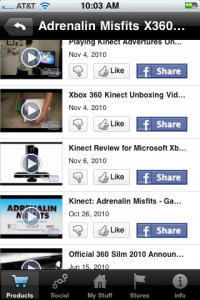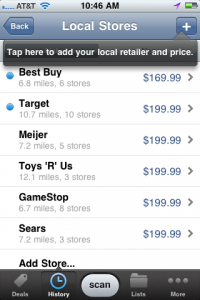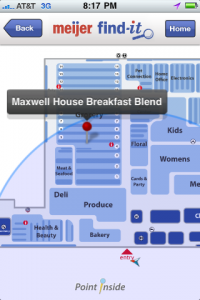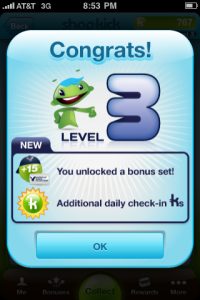5 mobile apps to take shopping
Posted on | November 26, 2010 | 1 Comment
If you have Black Friday off from work, my advice is to simply stay home and read a good book, interact with your kids or something else useful. If however, you are aching for a punishment and insist on pushing/shoving your way through crowded local retail venues, you might want to make sure you deck out your smart phone with the right shopping apps to help you survive the retail gauntlet that you will surely face. Here are five shopping-related smartphone apps that I think each offer something very unique and are worth trying out.

I scanned a XBox Kinect related product with Shop Social and it immediately found a set of videos of that product in action.
1. Shop Social: Ok, I’m a little biased when it comes this app. Shop Social developed by a team of CS graduate and undergraduates that I lead in GVSU’s Mobile Applications and Services Lab. We worked for almost a year on a shoestring budget and created an app that we think is rather unique in the retail smartphone app category. Just like most of the rest of the apps in this category it has a barcode scanner and is capable of retrieving product information on literally millions of products on store shelves around you.
However, that’s about all Shop Social app has in common with the rest of the pack. A key feature that Shop Social offers that is not available elsewhere is the ability to pull up rich media content on the products you scan – both videos and photos. While prices are obviously important when you are shopping, we think its also important to help the shopper immediately conceptualize the product, its potential, and relevance to the shopper’s perceived needs. If a picture is worth a thousand words, a video should be worth a few more! For example, let’s say you’ve heard about Wii Fit but aren’t sure exactly what it is or how it might work. Scan the product barcode when you encounter it in the store and immediately view YouTube videos of people using Wii Fit. So far, the video relevance varies by product and product category. For most consumer electronics and media/content related products the videos are almost always spot on. It doesn’t do bad in other product categories either, and it’s getting better every day. In addition to tweaking our own search heuristics (deployed in the cloud) we also incorporate usage data over time so as certain videos are more commonly viewed in a given product context, those videos start to make their way to the top of the list.
In addition to the rich media features, Shop Social is also tightly integrated with Facebook, offering you a sort of retail product related social dashboard where you and your friends can view and share each other’s product favorites/wishlist. You also have the expected features that might be expected with a Facebook integration (e.g., ability to post products, comments, product related video content to your Wall). However, the app will not post anything to your Facebook Wall without your explicit permission each and every time.
Finally, Shop Social supports a set of simple game mechanics that makes the experience a bit more fun and sticky. For example, scan your first product barcode, and bingo – you get a newbie badge! Share a few products or product videos on Facebook and you’re earning yet more badges. Visit a featured nearby store and interact with the app while you’re in the store and you get even more opportunities to out-badge your friends. This is an experimental app that we’re approaching from a learning/research perspective. We’re hoping to learn more about the potential of mobile technology in retail, and this is our first testing of the water. We’ve been quite pleased with the response the app has gotten so far, and hope you’ll give it a try as well. It’s available on both the iTunes App Store and the Android Market. Just search for “Shop Social” and it should show up right on top.

ShopSavvy lives up to its name when it comes to price comparison smartphone apps. Don't leave home without it!
2. ShopSavvy. In my opinion, ShopSavvy is the gold standard when it comes to barcode scanning smartphone apps. It has been a highly popular app on both iPhone and Android phones for quite a while now. ShopSavvy’s key feature is price comparison. You scan a product’s barcode and ShopSavvy does a magnificent job of finding just about every purchase opportunity you have for that product both online as well as in nearby bricks and mortar retail stores. ShopSavvy is so popular that I’m told some retailers will actually honor “competitor” prices if you show them the info that ShopSavvy retrieves when you scan the product’s UPC. I haven’t tried that myself, but in any case being well-informed before you purchase is good way to save yourself $$. In addition to prices, ShopSavvy does a great job of pulling down product reviews. The app also let’s you share product finds via Facebook, etc. In my opinion, the ShopSavvy barcode reading technology is the best available. We liked it so much that we licensed it for the iPhone version of our Shop Social app that was described above. If I was allowed to have only one barcode scanning app on my phone, ShopSavvy would be my first choice.
3. shopkick. When it comes to turning shopping into a game, shopkick wins hands down. Just recently, shopkick became available in the Android Market, so now all you droiders can play as well. Our experience thus far has been with the iPhone version. Basically you head off to partner stores (currently that includes Best Buy, Target, and others) and earn points (called kickbucks) automatically by simply walking in. You can garner additional kickbucks by scanning specific products. But wait a second, it’s not just about leveling up! Kickbucks can actually be redeemed in the form of mobile coupons, Facebook credits, and no doubt additional goodies each every day that save you real $$. The app’s user interface is well done and overall this is a great example of what can be done with mobile in a retail setting. If you are less interested in fun and earning coupons and more interested in finding information about products shopkick might not be what you are working for. The last I tried you can only scan a limited number of products that the app features.
4. Barcode Hero: We just became aware of Barcode Hero recently. The app is sort of a barcode scanner meets social graph experience. As you go around an scan/recommend products your activities get shared with other users who are using the app. Scan a product and you can see who else has recommended or owns it. In addition, the app also incorporates game mechanics. For example, when you scan a number of products of a particular category you can be come “duke” of that category. So, if you’re itching to become the “Queen” of “Home and Garden Features”, than this is the app you’ve been looking for! The app is generally well done. I like the user interface, and I think the idea of turning barcode scans and product likes into an activity stream and mapping it to social graphs is a good one. One potential concern I have is that by default everything you do is made public in the app and on their site. While that app makes that quite clear I sure hope folks buying gifts for friends and family also using app realize the app might be inadvertently spilling the beans! Barcode Hero is available on the iPhone and according to their website will be showing up on Android soon.

Meijer's Find-it is worthy of mention in that its the first of its kind: a retail branded smartphone app that supports in-store positioning.
5. Meijer Find-it: This app will be of less interest to readers who are not located in here in the great midwest. However, I include it on my list for a couple of reasons. First, Meijer (a regional retail chain) is headquartered here in West Michigan and I’m fond of plugging all things “locally grown”! Second, and perhaps more important, this app marks a fairly significant step towards the future of retail in that it’s the first generally available retailer-branded smartphone app I am aware of that supports indoor-positioning technology. That said, the deployment is limited at this point and appears to be more of a pilot. The last I looked the in-store positioning feature was only available in some of the Grand Rapids, MI area Meijer stores. The app is based on Point Inside’s positioning platform. I had prior experience using Point Inside’s own app that provides maps and indoor positioning for malls and airports and found that app fairly useful in a variety of situations – especially when trying to quickly find the gate to my connecting flight with a tight time budget. I visited the Grandville Meijer store back in October and gave the app a try myself. Just for fun, I used it to try to locate the products in-store that the shopkick app promised me points for scanning. For the most part, the app did an uncanny job of pinpointing the products’ location on the store layout diagram, and I soon leveled up in the shopkick experience. 🙂 The two areas I had difficulty with were 1) during the evening that I was there the positioning technology didn’t work very well at all, it kept putting me out on the front curb. 2) It was difficult to search for a product. If I entered a more generic search term it seemed like hundreds of results showed up and there were no thumbnails to guide me to the specific product I had in mind. One thing that worked very well in the Meijer store was that I had excellent signal on my iPhone the entire time. One of the big issues I have with all the above apps is that often my signal strength is a single bar or non-existent when I’m inside many retail venues. Not so in Meijer’s Grandville store. I don’t know if they’ve simply got luck or if they actually have deployed signal boosting technologies in store, but this is definitely an area retailers needs to be thinking about as in-store smartphone usage continues to grow. All in all, Meijer Find-it is a step in the right direction and I hope it will eventually be available in all of their locations.
So these are my top 5 choices for mobile shopping apps. There are definitely other apps in this category worthy of mention including Red Laser, myShopanion, CheckPoints, etc. But this article is long enough already! What smartphone app(s) do you take shoppping?
Comments
One Response to “5 mobile apps to take shopping”
Leave a Reply


July 13th, 2011 @ 12:32 pm
Very interesting article! This point inside positioning platform sounds like very interesting technology, and might be the technology I need to incorporate an app idea I have that beforehand I thought would need to rely on NFC.